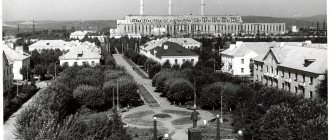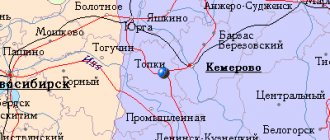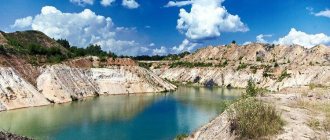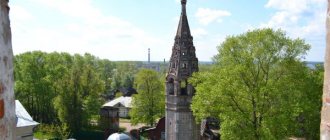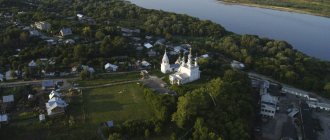| Flag of Novomoskovsk (Tula region) | Coat of arms of Novomoskovsk (Tula region) |
| A country | Russia |
| Subject of the federation | Tula region |
| Municipality | Novomoskovsk city |
| Former names | until 1933 - Bobriki until 1961 - Stalinogorsk |
| Telephone code | +7 48762 |
| Official site | https://www.nmosk.ru (Russian) |
| Ethnobury | Novomoskovsk residents |
| Timezone | UTC+4 |
| Postcode | 301650 (Main Post Office), 301660, 301670 |
| Chapter | Kozina, Elena Anatolyevna |
| Square | 76 km² |
| Day of the city | second Saturday in September |
| Population | ▼ 131,247[1] people (2010) |
| Center height | 240 m |
| City with | 1930 |
| Awards | |
| Vehicle code | 71 |
| Based | 1930 |
| Coordinates | Coordinates: 54°02′00″ N. w. 38°16′00″ E. d. / 54.033333° n. w. 38.266667° E. d. (G) (O) (I)54°02′00″ n. w. 38°16′00″ E. d. / 54.033333° n. w. 38.266667° E. d. (G) (O) (I) |
| OKATO code | 70 424 |
Novomoskovsk (before 1934 - Bobriki; from 1934 to 1961 - Stalinogorsk) is a city in the Tula region of Russia, the center of the municipal formation "city of Novomoskovsk".
The population as of January 1, 2010 was 131,247 people (125th place in Russia and second in the Tula region). The area of the city without adjacent rural areas is 76 km.
The city was founded in 1930 in connection with the start of construction of the largest chemical plant in the USSR. The city is located in the northern part of the Central Russian Upland between the Don and Shat rivers, 220 kilometers southeast of Moscow and 60 kilometers southeast of the regional center of Tula. Within the boundaries of Novomoskovsk is the source of the Don River. It is a major economic and industrial center of the Tula region, one of the cores of the polycentric Tula-Novomoskovsk agglomeration.
General information and history of the city of Novomoskovsk
Novomoskovsk is the second largest and most important city in the Tula region, which is a major industrial center of the Russian Federation.
The city is located in the basin of two great rivers: the Don and the Volga and stands at the ancient Ivan Lake, glorified in folklore, from which two streams flow: the Don and the Shat, which flow into the Upa River. Novomoskovsk is located between them. The shape of the area under the city resembles a triangle. The center of the triangle is the highest place in the Central Russian Upland.
The height of the city above sea level is 230 meters. The terrain is characterized by the presence of a large number of shallow hollows that roll down to the headwaters of rivers such as Lyubovka, Bobrik, Kamenka and Orlovka . Steppe and forest-steppe predominate. The territory of the district is quite actively plowed under farmland. In some places, islands of the once mighty forests of the Urvan and Kryukov forests are visible.
Old Novomoskovsk
Novomoskovsk is located 220 kilometers south of the capital and 60 kilometers southeast of Tula.
In the 18th century, when Russia gained access to the Black Sea, and the Don became the main river of the country, Peter the Great began construction of a canal here that was supposed to connect the two main waterways of Russia - the Don and the Volga. But the project did not justify itself, and construction was curtailed. At the same time, deposits of brown coal were discovered here, to which Novomoskovsk owes its birth. Even before the 1917 revolution. here, not far from the Bobriki station, mines grew.
Novomoskovsk appeared initially as the village of Bobriki , part of the estate of the Bobrinskys , illegitimate descendants of Count Orlov and Empress Catherine II . The official date of formation of the city is 1930. It was then, at the time of general industrialization of the country, that it was decided to build a plant for the production of nitrogen fertilizers here.
Construction in Bobriki was one of 18 “super-impact” construction projects of the first five-year plan. In 1934 Beavers began to be named in honor of I.V. Stalin Stalinogorsk. And only in 1961 it received its current name.
During the Great Patriotic War, it was occupied by German invaders from November 22, 1941 to December 11, 1941. It was liberated during the Tula operation by troops of the Western Front.
Memorial to those who fell on the fronts of the Great Patriotic War
Novomoskovsk (Ukraine)
The monument was opened in 1981 on the site of a mass grave of Soviet soldiers who died in the battles for Stalinogorsk. In December 1941, in the Urvan forest, 165 soldiers and officers were buried there. The central object of the memorial is a sculpture of a grieving mother. A white arch rises above it. Nowadays, the memorial has been supplemented with black cubes with the names of all 7,668 Stalinogorsk residents who did not return from the war fronts, a tank and artillery pieces of those times. And the Urvan forest received the name “Memorial complex “Park of Memory and Glory”.
Memorial to those who fell on the fronts of the Great Patriotic War
Location: st. Pashanina / Parkovy proezd.
Climate and ecology of Novomoskovsk
The climate is temperate continental, relatively mild and moderately humid. The main wind direction is western, southern and southwestern. The average annual temperature is +5 °C. There are fairly warm summers (average July temperature is +18.4°C) and moderately cold winters. Annual precipitation is approximately 500-700 mm, incl. in winter – approx. 100 mm, in spring – approx. 110-120 mm, in summer – approx. 200 mm, in autumn - approx. 130 mm.
Novomoskovsk confidently stands in the mournful ranks of 99 Russian cities that have an unfavorable environmental situation. The population of Novomoskovsk is exposed every minute to the harmful effects of a number of environmental factors, incl. chemical, physical, social, and the most important of which is air pollution.
More than 95% of emissions (among stationary sources) are emissions from 13 industrial enterprises of the city. In 2010 the total emissions from stationary sources of pollution amounted to more than 13.5 thousand tons, although city leaders reassure residents that this is as much as 881 tons less than in 2009.
Another source of air pollution is emissions from motor vehicles. According to the State Traffic Safety Inspectorate, the number of vehicles over the past 10 years has increased from 20 thousand to 44.5 thousand.
But the most pressing environmental problem of the city is that, along with the already fairly high level of environmental pollution received from industrial enterprises, the territory of Novomoskovsk fell into the zone of radioactive fallout that formed as a result of the accident at the Chernobyl nuclear power plant in April 1986.
Currently, the city belongs to a zone with preferential socio-economic status. The average level of soil contamination with cesium-137 is 3.53 ci/sq.km. Only some territories located in the north and northeast of the region remained clean on the territory of the Novomoskovsky district. The total area of the territory affected by radioactive contamination is approx. 692 sq. km, on which 170 thousand people live, of which 30 thousand people. – children under 14 years of age.
Source of the Don
Of course, the great Russian river Don has several sources. Initially, it generally flowed out of Ivan Lake, which was absorbed in the 1930s by the man-made Shatsky reservoir. It is not located in the Children's Park of Novomoskovsk, but six kilometers northeast of it. Another natural source of the Don is the Urvanka River, which from time immemorial flowed near Ivan Lake and was fed by underground springs emerging from limestone rocks near the village of Urvanki.
Therefore, the Source of the Don in the Children's Park of Novomoskovsk is nothing more than an allegory, a special tourist attraction, a “calling card” of the city. The stone from under which the “source of the Don” flows was erected here in 2000, and the water there flows not from an underground spring, but from the city water supply network.
Source of the Don
The bed of the man-made stream then stretches under the pedestrian bridge, under the rails of the children's railway, goes deep into the park, and then gets lost somewhere in the grass. However, the water from it, as well as from the cascade of man-made ponds in the Children’s Park, then actually flows into the Urvanka River (now very swampy in places, in places turning into a barely noticeable stream). And from it - to the Don.
Population of Novomoskovsk
The total population of the entire municipality as of 01/01/2014. – 140 thousand people (territory area - 888 sq. km). Urban population, excluding residents of adjacent territories - 128 thousand people. (area 90 sq. km). At the same time, for each Novomoskovsk resident there is about 300 sq. m of green space, which significantly exceeds urban planning standards.
The Novomoskovsk municipal formation includes the Sokolniki microdistrict (which until recently was a separate city and located 10 km from Novomoskovsk with a population of 10.6 thousand people), as well as rural settlements with a total population of 13.3 thousand people. , the largest of them are Gremyachee, Spasskoe, Riga-Vasilievka .
44.8% of the total population are men, 55.2% are women. At the same time, there is an aging of the city's population, since the majority of it is still pensioners - 56.4%, children under the age of 18 account for 22.4%.
In general, the demographic situation in the city is assessed as unfavorable. Every year the population of Novomoskovsk decreases by 1-2%, which is associated with a high mortality rate and a fairly low birth rate. The natural population decline in 2010 was 8.8 people. per 1000 people But it is encouraging that over the past five years there has been a tendency towards a reduction in population loss and an increase in the birth rate.
Such demographic indicators clearly demonstrate the fact that the living conditions of people on the territory of Novomoskovsk leave much to be desired. The high level of saturation of the city with hazardous industries, combined with the severe consequences of radioactive contamination as a result of the disaster at the Chernobyl nuclear power plant, explain the low, and even, one might say, deplorable level of people’s health.
Brides Alley
In this regard, environmentally-related diseases associated with damage to the endocrine system, upper respiratory tract, gastrointestinal tract, immunity disorders, malignant neoplasms, etc. are widespread among the city's population. And the high content of phenol in the city's atmosphere clearly correlates with morbidity rates children with pharyngitis and bronchitis.
As for the education of Novomoskovsk residents, it can be noted that many young and mature residents have a higher or at least secondary specialized education. Studying somewhere after graduating from school is considered prestigious, so few schoolchildren go to college after the 9th grade, but continue their studies in the 10th-11th grade in order to then enter an institute or technical school. Fortunately, the conditions for this have been created in the city.
Since the 60s of the last century, the Institute of the Russian Chemical-Technological University named after. D.I. Mendeleev with a wide range of specialties: from purely chemical to management and financial. Already in recent decades, a social and humanitarian institute, a branch of the University of the Russian Academy of Education, as well as a Representative Office of the Moscow State Transport University (MIIT), and the Institute of Public Utilities have been opened.
Secondary vocational education can be obtained in 10 educational institutions, among which stand out the music school, medical college, Novomoskovsk construction technical school, and chemical physical education technical school.
Of course, not all graduates of universities and secondary vocational educational institutions realize themselves in their chosen profession; some, in pursuit of the “long ruble,” go to the capital, but not all really find profitable employment there (many parents for some reason are extremely proud that their children live not just anywhere, but in Moscow itself. At the same time, living conditions there and status are not taken into account), and those who remain in the city are divided into those who, thanks to their parental connections, successfully found a job in large city-forming enterprises, and calmly do a career there, i.e., as they say, he managed to get on his “social elevator”, and for those who were late for it - they have a direct path to sales managers, who are so in demand in Novomoskovsk due to the rapid growth of the consumer market and the opening of many stores and shopping centers, or other small commercial structures.
Traditionally, the ancestors of Novomoskovsk residents are considered to be the ancient tribes of the Vyatichi, who were distinguished by their good nature and hospitality, which cannot be said about the current residents of the city. Kindness and cordiality are not their traits. Smiling and friendly people are a rarity here. Mostly these are stern and somewhat embittered faces. The population of the city cannot be called well-educated either, especially for the younger generation, but this is most likely a problem not of a specific city, but of the spiritual and moral crisis of Russia as a whole.
Coat of arms
The coat of arms of Novomoskovsk is presented in the form of a French shield. The red background at the top shows a golden hammer on top of two silver pickaxes in a criss-cross pattern. Below on three green hills lie golden amphorae overturned and facing each other. Silver streams pour out of the vessels. An optional element is to decorate the shield with the ribbon of the Order of the Red Banner of Labor.
The artistic composition was approved on March 24, 1999 by decision of the Council of Deputies of the municipality of Novomoskovsk No. 27-1. Included in the State Heraldic Register of the Russian Federation under No. 454. The author of the coat of arms is Honored Artist of the Russian Federation M. Shelkovenko.
Districts and real estate of Novomoskovsk
The planning structure of the city is quite complex and was formed during the Soviet Union. The city territory consists of two conventional districts, the Northern planning area and the Southern one, which are separated by a 12-kilometer sanitary protection zone.
The northern planning area is an area of main industrial production; also in this area there is a residential microdistrict, popularly called “North”. It is located in the protective and sanitary zone of the Northern Industrial Hub.
In the southern part of the city there are the main residential areas, the administrative and cultural center of the city.
Novomoskovsk map
Novomoskovsk map
“North” is the very first residential buildings in the city, which were built next to the chemical plant for its builders and workers. Famous architects, the Vesnin brothers, took part in the implementation of the construction plan.
As mentioned above, the area belongs to the sanitary protection zone and is therefore subject to resettlement. The number of its residents is steadily decreasing every year due to the relocation of residents to new buildings in other areas of the city (Zalesny, Urvan microdistricts, etc.). Thus, this area is currently somewhat neglected.
The southern part of the city includes the following areas:
- The immediate central part of the city with the adjacent neighborhoods, called simply “the city” (this name is especially relevant for residents of microdistricts. When going to the city center, they usually say: “Let's go to the city”)
- North-Western (the name is purely conditional, not popularly used), which extends to the west from the city center and to the east from the village of Kamenetsky. It, in turn, includes: 1-6 Urvan microdistricts, Gypsum microdistrict, villages 22 and 26 mines, Northern microdistrict.
- 1st and 2nd Zalesny microdistricts, located in the east of the city (construction of the 3rd Zalesny microdistrict has already begun)
- Microdistrict "Lugovaya" - in the eastern part of the city
- District "Vakhrushevo" - located in the southeastern part
- Southern district (the name is purely conditional) - located in the south of the city, it includes the villages: Klin, Zapadny, Shamotny, Mages
The central part of the city includes blocks adjacent to the two main streets of the city - Moskovskaya and Komsomolskaya (which are the unique face of the city), as well as blocks 16, 17, 19, station blocks, incl. 26th block and children's park, streets in the area of the city hospital and the central market, the area between the street. Kalinina and Sverdlov St., st. Mayakovsky and st. Shakhtyorov, "Carpets-Furs".
The city center was built up mainly in the 40-50s of the 20th century. The central part of Novomoskovsk is characterized by a straight and strict layout of streets. is Sovetskaya Square, onto which the facade of the former building of the Moscow Region Coal Research Institute overlooks (now VTB-24 and numerous offices are located here). Nearby is the municipal administration building.
combines pre-war and post-war architecture in the Stalinist Empire style and constructivism: these are houses with arches, columns, large apartment areas and high ceilings. Such iconic residential buildings are more typical of Moskovskaya Street and the Sovetskaya Square area.
During the Great Patriotic War, the city suffered severe destruction. German captured soldiers also took part in its restoration and new construction. In the post-war years, two-story houses were erected on the street. Labor reserves, Berezovaya, Mayakovsky. In the 60s, the mass construction of the so-called “Khrushchev buildings” began. It was then that the station area, the “Carpets-Furs” area (received this name from the store of the same name located there in Soviet times), the 19th quarter, etc. were built. Currently, active construction of new residential complexes is underway in the central part of Novomoskovsk. Houses were erected on Trudovye Reservy/Moskovskaya, Kalinina, Kukunina, Sverdlova, and Sadovsky streets.
New houses on Kukunina Street
Since Soviet times, representatives of the upper strata of society lived in the city center - heads of various enterprises, leading specialists in the chemical and construction industries, doctors, engineers, etc. There were also communal apartments here (by the way, they still remain), where they lived (and live) in several families. Living in the central part of the city is very convenient. Everything you need for life is nearby - a market, a train station, a theater, and all kinds of entertainment venues. Again, residents of the “city” are always aware of the cultural life of the city, because most festive events are held in the central square of the city.
Housing prices in the city center are higher than in other areas of the city. Only wealthy people by the standards of Novomoskovsk can afford to buy an apartment here, and even remodel it at their own discretion. So, for example, the price of a 1-room apartment in the center ranges from 1 million rubles to 1.5 million (depending on the distance directly from the central blocks and the degree of newness of the house and the condition of the apartment), a 2-room apartment - from 1.2 to 3 million, 3-room – 1.8 million.
In areas adjacent to the center, such as blocks 19 and 26, “Carpets-Furs” and others, the population is simpler, and prices are somewhat lower.
The central part of the city is surrounded by greenery. All plantings are artificial. In the parks located here - Birch Grove and Children's Park, mainly birch, larches and oaks are planted. In landscaping the streets and courtyards of the center, preference is given to linden, chestnut, ash, birch, apple and rowan trees. As necessary, old trees are replaced with young seedlings. Moskovskaya, Kalinina, and Sverdlova streets have updated their green attire.
As for the Urvansky and Northern microdistricts in the northwestern part of the city, their construction took place in the 70-80s. last century. Mostly these are 5-9 storey panel houses, sometimes there are brick ones. There are also new buildings here, the prices for apartments in them are naturally much higher than in old buildings. The population of the districts is quite easy to communicate; mainly the working and middle class of the city live here. Housing prices are as follows: 1-room apartment - 900 thousand - 1 million 100 thousand rubles, 2-room apartment - 1200 thousand - 1700 thousand rubles, 3-room apartment - 1700 to 4000 thousand rubles (new houses).
Gypsum - this is simply the name of the village of the Gypsum Plant, also located in the north-west of the city. It was built by the Novomoskovsk gypsum plant, which began its work in the 50s. XX century and continues production to this day. The main building of the microdistrict is an old two-story building in combination with relatively new buildings of 5 and 9 floors. Mostly working people live here - former and current workers of the gypsum plant and their descendants. Due to the sufficient distance from the city center, prices for apartments here are quite low: 1-room apartment - 800 thousand-900 thousand rubles, 2-room apartment - 1100-1300 thousand rubles, 3-room apartment - 1500 thousand rubles.
The Zalesny microdistrict was built mainly in the 70-80s. Its active development continues to this day, expanding the boundaries of the area to nearby villages. It received its name due to the fact that it is separated from the central part of the city by the Urvan forest, which previously belonged to Count Bobrinsky, the presence of which has a beneficial effect on the ecological situation of the microdistrict. In addition to the forest, where you can walk and breathe fresh air in the summer and ski in the winter, in the east the microdistrict is surrounded by the greenery of the villages of Bolshoye and Maloye Kolodeznoye.
Residential buildings at the beginning of the development of the microdistrict are mostly panel, but there are also brick ones. Late 80's - early. 90 construction of a series of 9-story buildings began here. The residential areas currently under construction are mostly 10-story brick.
Zalesny is a relatively young microdistrict - mostly young people and mature people live here. The social composition is quite mixed - from ordinary workers to managers at various levels. Prices: 1-room apartment - from 900 to 1600 thousand rubles, 2-room apartment - on average 1800 thousand rubles, 3-room apartment - from 2000 thousand rubles.
The Vakhrushevo microdistrict is named after its main street - Vakhrusheva. This area is located behind the city bus station, on the right hand from the entrance to the city from the city of Uzlova. Its construction was carried out in the 60-80s, so basically all residential buildings are panel “Khrushchev” buildings. In this regard, the housing prices here are corresponding: 1-room 900 thousand, 2-room -1300-1400 thousand rubles, 3-room - 1600 thousand rubles.
Private residential development is represented by the Lugovaya microdistrict, the so-called “beggars’ valley”, which can be found in any city. If you have a house on Lugovaya, then, undoubtedly, you belong to the elite population of our city. Prices for houses here are unlikely to compare with prices for similar cottages in the cities of the Moscow region. Here you can find both very modest houses and “palace ensembles”... The cost of cottages on Lugovaya starts from 7 million rubles.
Lugovoi Cottages
Private houses are also located in the southern part of the city - this is the village of Zapadny.pos. Klin, in the "Carpets-Fur" area, on Vakhrushevo. Here you can buy a house a little cheaper - from 3 million rubles.
Palace of Culture
The Palace of Culture of Chemists - the main center of culture of Stalinogorsk - was built, like the whole city, at an accelerated pace: in 1935-1936.
this rather large building was erected. Amateur artistic groups, party and Komsomol conferences immediately started working there, and the local theater gave performances and showed films in the auditorium. The entire third floor of the building was occupied by a large library with a reading room. In 1954, it was moved out of it into its own separate building. During the Great Patriotic War, conscripts and militias gathered in front of the Palace of Culture, from here they went to the front. During the 17-day occupation, German soldiers, right in the middle of the auditorium of the Palace of Culture, lit a fire from its chairs and warmed themselves. But in general, the building of the Palace of Culture was relatively well preserved in the war-ravaged city, and resumed work already in 1942.
Palace of Culture
Nowadays, the Palace of Culture lives an active creative life: every year it holds up to hundreds of concerts, festive evenings, competitions, entertainment programs, performances for all age categories of residents of the city and region.
Address: st. Moskovskaya, 10.
City infrastructure
Like any other Russian city, Novomoskovsk is not spared from housing and communal problems.
The main problem of the city, inherited from Soviet times, is the problem of water supply. This problem has always been most acute in the central part of the city and the Vakhrushevo microdistrict. Water was provided here strictly by the hour - from 6 a.m. to 1 p.m. and from 5 p.m. to 10 p.m., and the residents of the top floors practically did not see it. This is due, first of all, to the deterioration of the networks and the fact that the existing artesian wells cannot provide the population with the necessary amount of water. Recently, the situation with water supply has improved a little, there is water almost all day long (at night the water is most often turned off, even on New Year’s!), but sometimes the previous shutdown regime is introduced.
There are also frequent emergency situations at water intakes, which happen quite often and, moreover, most often on weekends and holidays, as well as with the slightest rain, wind, snowfall and other vagaries of nature. The authorities promise to radically change the situation with water supply this year. The head of the city administration sees the main solution to the problem in the restoration of the mines, when it will be possible to use previously mothballed wells. An alternative to this is the use of water resources from the Pronsky Reservoir.
If we talk about utility bills, then city residents pay the full cost of the housing and communal services provided to them. Based on official statistics, the share of expenses for housing and communal services in household expenses is about 22%. In fact, the cost of these services is as follows: cold water – 189 rubles/person, sewage – 101 rubles/person, maintenance and repair of housing – 8.67 rubles/sq.m, garbage removal – 1.08 rubles/ sq.m., heating – 20.29 rubles/sq.m., electricity – 2.84 rubles/kWh, gas – 3.50 rubles. per cubic meter (standard - 25 cubic meters per person), telephone - 264 rubles. On average, without taking into account benefits, it turns out to be 2-3 thousand rubles (depending on the area of the apartment, the number of registered people and the type of water supply).
The problem of urban roads is also quite acute. Getting from home to work and back by car, even in such a small town as Novomoskovsk, is not so easy. There are two main reasons for this.
The first is “traffic jams” (albeit a little, but they exist). This is explained by the fact that recently the number of cars has sharply increased (every third city resident is a car owner), and the city’s roads are simply not designed for such traffic flow, therefore, their radical reconstruction is necessary to increase their capacity. The main accumulations of cars are observed in the area of the Central Market on Sadovskogo Street, on Mira Street and Ryazanskoe Highway. The only good news is that in the nearest plans of the city leadership there is still an item on the construction of several new roads and the expansion of existing ones with the organization of parking bays and roundabouts.
The second reason is that city roads need high-quality (!) replacement of the road surface. The condition of Novomoskovsk roads is deplorable. And this problem worsens as soon as the snow begins to melt. All the main (even recently repaired!) highways in the city turn into continuous potholes, which require a certain amount of driver skill to get around...
As for roads in courtyards, this is a separate conversation - most of the internal areas have not been repaired since the houses were built. Many sidewalks on the main streets of the city are also in need of asphalt replacement for a long time. Although since last year the process has moved from a dead point - the arrangement of some pedestrian zones of the city has begun. I would like to hope that this good initiative will be continued further.
Public transport in Novomoskovsk is represented by electric trains, buses and minibuses. The city electric train line has 13 stations. In Novomoskovsk there are 23 city bus routes and 21 suburban ones. From the city bus station you can get to Tula, Ryazan, Moscow, Voronezh, Orel, Bogoroditsk, Efremov, Skopin.
In the immediate vicinity of the city there is the M4 Don federal highway, as well as the P132 Kaluga - Tula - Mikhailov - Ryazan.
Novomoskovsk was founded as a city of chemists, so the traditions of good education have been preserved here. There are a sufficient number of secondary schools in the city (40 of them), among which there are gymnasiums (MOU "Gymnasium No. 1" and MOU "Gymnasium No. 13") lyceums (MOU "Lyceum" and MOU "Lyceum "School of Managers"), 3 schools - boarding school, auxiliary school.
Lyceum School of Managers
There are 52 preschool institutions in the city, which, of course, does not fully meet the city’s needs. Many parents have to face certain difficulties in order to enroll their child in kindergarten. This is especially true for residents who try to get into kindergarten when their child reaches three years of age. Not everyone succeeds. In areas adjacent to the city center and in microdistricts, as a rule, it is easier to get a job in a kindergarten. You only need to submit a corresponding application one year before the expected date of arrival at the preschool institution.
To solve problems with preschool educational institutions, an electronic queue for registering a child in kindergarten operates on the official website of the city, and to reduce this queue, additional groups are opened in existing kindergartens due to inefficiently used space and their corresponding equipment, and some large companies.
Hymn
There are many famous cities in the world. Everyone has their own path, history and growth. Your shrines. But, to be honest, there is no better place than my Novomoskovsk!
Chorus:
Grow, my city, a corner of Russia, In the crown of parks, squares and gardens. Be the youngest under the blue sky From the youngest of our cities!
The beauty of Great Rus', the quiet Don, flows free and wide, but only here, with us, are its origins, in my unique city.
Chorus:
Grow, my city, a corner of Russia, In the crown of parks, squares and gardens. Be the youngest under the blue sky From the youngest of our cities!
You are not the capital of either a country or a region, But you are unique in your destiny. And every evening the heart skips a beat, And longs for the songs of your streets.
Words by V. Kireev, music by S. Igolnitsyn.
Approved on July 24, 2009.
Enterprises and work in Novomoskovsk
Novomoskovsk today is a modern, developing large industrial center of Russia, which is the main supplier of revenue to the budget of the Tula region. The city occupies a leading position in the country in terms of production of mineral fertilizers and other chemical products.
Novomoskovsk nitrogen
More than a hundred large industrial and construction enterprises now operate in Novomoskovsk. Small and medium-sized businesses are actively developing, the number of shopping centers, catering establishments, medical services, etc. is growing rapidly. The economic partnership of Novomoskovsk with other regions of Russia and foreign countries is widely developed.
Since 2007 The city is implementing the largest domestic investment project to create an industrial and economic cluster in the region. As part of this project, new production facilities were launched in the city, as well as engineering and transport infrastructure, which currently fully meet the needs of the rapidly developing economy here. Thus, the city creates all the necessary conditions for increasing the number of jobs and improving the standard of living of the population.
The largest city-forming enterprise of the city is the Azot research and production association, currently part of the largest mineral and chemical enterprise, which unites enterprises for the extraction of raw materials and the production of chemical products, transport divisions and an extensive sales network throughout Russia and abroad. The Novomoskovsk division of the company is constantly increasing production volumes, modernizing existing and creating new production facilities, mastering the production of new types of products, and, therefore, is constantly in need of labor resources. In addition, Eurochem is one of the few companies in the region that pursues an effective social policy and cares about the safety, health and well-being of employees.
Today, almost every resident of Russia is familiar with P&G products. But not everyone knows that one of the company’s largest factories is located in Novomoskovsk. Tide, Ariel, Myth, Tix washing powders, Fairy , Ace, Lenor, MrProper, Comet detergents and Pampers baby diapers are produced here. The company takes very good care of its employees, offering them personal training and development programs, a compensation package and all kinds of benefits, including voluntary medical insurance for all family members, free food, transportation to their place of work, etc. But getting into prestigious vacancies is not easy. (traditions of getting a job “through connections” continue to work even though the entire management of the company consists entirely of Americans), although officially the Procter & Gamble company says that it hires young specialists and university graduates with mandatory English language proficiency, regardless of the position . As for working professions, forklift drivers and stackers-packers are always required here. The procedure for applying to a company is as follows: first, fill out an application for the vacancy of interest, then fill out a questionnaire, then a test for operational thinking, the last stage is a conversation with a representative of the department to which the application was submitted. In general, the selection process (from filling out the application to starting work) can take about a month.
P&G in Novomoskovsk
Another large enterprise in the city is a plant for the extraction of gypsum and the production of building materials of the world famous KNAUF brand. The mine has existed since the 50s. and the gypsum plant has always been a locomotive that actively developed the social sphere and took care of its personnel. The traditions begun in Soviet times are still maintained by the owner of the plant, the German company KNAUF. The company does its best to preserve the health of its employees, namely, provides the opportunity for free outpatient treatment, as well as to develop the professional qualities of its employees. The individual social package of each employee is determined, first of all, by the length of service in the company. Knauf-Gips-Novomoskovsk employees have the opportunity to improve their qualifications or obtain a second higher education with further provision of work in their specialty, as well as purchase Knauf building materials at a discounted price.
KNAUF
Employees are provided with free outpatient medical care, assistance in purchasing vouchers for summer vacations and other benefits.
Among other large enterprises in the city are Orgsintez, Poliplast, GOTEK-, and others.
The share of retail trade turnover in Novomoskovsk is about 10% of the total retail trade turnover in the Tula region; in terms of retail sales, the city ranks second after the regional one - undoubtedly, the central market, followed by all kinds of shopping malls, "Line" (opened in December 2011 and which provided employment for almost 600 city residents), Hermes, Divo, and new sales centers are constantly being built.
Central Market
Crime
Despite the fact that there is an opinion on the Internet that Novomoskovsk in the Tula region is the safest city in Russia, since only 105 crimes are committed there per 10,000 residents, the city prosecutor calls the criminal situation in the city quite complex. Currently, there is an increase in the number of murders, rapes, and fraud.
Crimes committed in the field of medicine and education receive great public attention. Thus, in February of this year, due to the fault of doctors, after gastric lavage and improper resuscitation actions, a one-and-a-half-year-old girl died in a children's infectious diseases hospital.
Last year, activists of the Pedophile Hunters movement caught a pedophile with live bait, who turned out to be a teacher of Russian language and literature. Following the appearance of a video on the Internet, which recorded a meeting between members of a public movement and a teacher suspected of pedophilia, a pre-investigation check was carried out. But Russian legislation does not yet allow law enforcement agencies to isolate such a “teacher” from society.
Loud crimes have happened in the city before. So in 2006 In Novomoskovsk, a contract murder of a businessman was committed. On a narrow path near his house, he met his killer. The attacker shot professionally and most likely in the head. And this is not the first contract killing of entrepreneurs since the beginning of market times. In 1993, on the order of a former business partner, one of the most successful Novomoskovsk businessmen, Sergei Panteev, was shot with a machine gun at the entrance of his house. The killers were caught with a machine gun leaving the city that same evening.
Holy Dormition Monastery
Novomoskovsk (Tula region): attractions
The city of Novomoskovsk is a creation of the Soviet regime, and there were no religious institutions in it until 1990, when a house of worship opened in the building of the former Lada cafe. On the basis of this building, after its repeated reconstruction, the Assumption Church began operating. In 1995, the Holy Dormition Monastery was founded in Novomoskovsk by the Russian Orthodox Church.
Holy Dormition Monastery
In addition to the Assumption, on its territory the Intercession of the Blessed Virgin Mary and a summer church in honor of the Holy Myrrh-Bearing Women, as well as buildings for the cells of the brethren, were built. There is a wall around the monastery with five towers, which have their own names, and three gates. There is a Sunday school at the monastery, attended by more than a hundred pupils, as well as a Sunday school for adults and a Parents' Club.
Address: Parkovy passage, 6.




